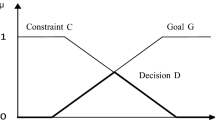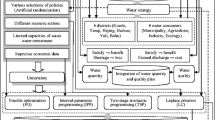Abstract
Establishing rational water resource allocation planning is critical for controlling risks within the water resource system and mitigating supply–demand pressures. Various risk elements within a water resource system transform, making it challenging to accurately represent the system response to different risk control measures using mathematical models. Therefore, in response to the risks and uncertainties present in the allocation process, this study aims to maximize comprehensive regional economic benefits. It combines risk control measures with balanced development strategies as model constraints and introduces approaches such as discrete intervals and fuzzy numbers to characterize multiple layers of uncertainty. Applying this model to a case study in Beijing, the results reveal that the overall water supply situation for the city in 2030 is not optimistic, particularly when both Beijing and the Danjiangkou Reservoir experience reduced inflows, potentially leading to a water supply deficit of [5.79 × 108, 10.90 × 108] m3.





Similar content being viewed by others
Availability of Data and Materials
The datasets generated during the current study are available from the corresponding author on reasonable request.
References
Arab AM, Gocić M (2021) Analyzing the applicability of some precipitation concentration indices over Serbia. Theor Appl Climatol 146:645–656. https://doi.org/10.1007/s00704-021-03743-5
Bai T, Wei J, Chang FJ et al (2019) Optimize multi-objective transformation rules of water-sediment regulation for cascade reservoirs in the Upper Yellow River of China. J Hydrol 577:123987. https://doi.org/10.1016/j.jhydrol.2019.123987
Birge J, Louveaux FV (1998) A multicut algorithm for two-stage stochastic linear programs. Eur J Oper Res 34(3):384–392. https://doi.org/10.1016/0377-2217(88)90159-2
González SO, Almeida CA, Calderón M et al (2014) Assessment of the water self-purification capacity on a river affected by organic pollution: application of chemometrics in spatial and temporal variations. Environ Sci Pollut Res 21:10583–10593. https://doi.org/10.1007/s00704-021-03743-5
Huang GH, Loucks DP (2000) An inexact two-stage stochastic programming model for water resources management under uncertainty. Civ Eng Syst 17(2):95–118. https://doi.org/10.1080/02630250008970277
Li R, Guo P, Li J (2018) Regional water use structure optimization under multiple uncertainties based on water resources vulnerability analysis. Water Resource Manag 32:1827–1847. https://doi.org/10.1007/s11269-018-1906-8
Li Y, Huang G (2008) Interval-parameter two-stage stochastic nonlinear programming for water resources management under uncertainty. Water Resour Manag 22(6):681–698. https://doi.org/10.1007/s11269-007-9186-8
Liu J, Li Y, Huang G et al (2016) An integrated optimization approach for river water quality management and risk analysis in a rural system. Environ Sci Pollut Res Int 23:477–497. https://doi.org/10.1007/s11356-015-5250-8
Liu H, Huang G, Li Y et al (2017a) Two-stage stochastic programming model for water resources management under uncertainty: A case study of the Huai River Basin in China. J Hydrol 546:305–316
Liu D, Liu W, Fu Q et al (2017b) Two-stage multi-water sources allocation model in regional water resources management under uncertainty. Water Resour Manag 31:3607–3625. https://doi.org/10.1007/s11356-014-3098-y
Maqsood I, Huang GH, Yeomans JS (2005) An interval-parameter fuzzy two-stage stochastic program for water resources management under uncertainty. Eur J Oper Res 167(1):208–225. https://doi.org/10.1016/j.ejor.2003.08.068
Meng FD, Wang XY (2004) Analysis of the current status and driving forces of water resource carrying capacity in Beijing City. J Capital Norm Univ (Nat Sci Ed) 03:100–105. https://doi.org/10.3969/j.issn.1004-9398.2004.03.023
Niu G (2016) Interactive fuzzy stochastic optimization approach applied to agricultural water resource allocation: A case study in the hetao irrigation district of inner Mongolia. North China Electric Power University (Beijing). https://doi.org/10.7666/d.Y3115259
Qi ZC (2011) Study on joint operation of multiple water sources in Beijing under the South-to-North Water Diversion Conditions. Tsinghua University. https://doi.org/10.13243/j.cnki.slxb.2014.07.011
Raei M, Hossienzad J, Ghorbani MA (2023) An uncertainty-based random boundary interval multi-stage stochastic programming for water resources planning. Water Resour Manag 37(2):4571–4587. https://doi.org/10.1007/s11269-023-03557-2
Shang Y, Lu S, Li X et al (2017) Balancing development of major coal bases with available water resources in China through 2020. Appl Energy 194:735–750. https://doi.org/10.1016/j.apenergy.2016.07.002
Su XY, Yu Y, Zhao JS et al (2019) Game equilibrium of water resources allocation among Beijing’s administrative districts after the operation of the South-to-North Water Diversion Middle Route. Appl Basic Eng Sci J 27(02):239–251. https://doi.org/10.16058/j.issn.1005-0930.2019.02.001
Uhlig H (1998) The robustness of identified VAR conclusions about money: A comment. Carn-Roch Conf Ser Public Policy 49:245–263. https://doi.org/10.1016/S0167-2231(99)00010-X
Wang S, Huang G (2011) Interactive two-stage stochastic fuzzy programming for water resources management. Environ Manag 92:86–95. https://doi.org/10.1016/j.jenvman.2011.03.024
Wang ZJ, Ma ZZ, Liao SH et al (2013) Study on the economical appropriateness of floodwater resource utilization: A case study of the Haihe River Basin. J Hydroelectr Eng 32(01):11–18
Wang Y, Li Z, Guo S et al (2020) A risk-based fuzzy boundary interval two-stage stochastic water resources management programming approach under uncertainty. J Hydrol 582:124553. https://doi.org/10.1016/j.jhydrol.2020.124553
Wu X, Chen ZX, Wen QB et al (2021a) Reinforcement learning-based model for optimizing unconventional water resources allocation. J Hydraul Eng 40(7):9. https://doi.org/10.11660/slfdxb.20210703
Wu X, Wang YJ, Yao Y et al (2021b) Urban Water Resources Optimization and Allocation based on Interval Two-Stage Approach. Hydraulic and Hydropower Technology 52(10):11
Xu H (2013) Research on water pricing for multi-source water supply in the receiving area of South-to-North Water Diversion Project. Beijing, China Institute of Water Resources and Hydropower Research 101–104
Xu Y, Huang G (2016) A risk-based interval two-stage programming model for agricultural system management under uncertainty. Math Probl Eng. https://doi.org/10.1155/2016/7438913
Yu H, Li L, Li J (2020) Integrated assessment of water resources carrying capacity in the Beijing-Tianjin-Hebei region based on quantity-quality-zone-flow. Resour Sci 42(2):358–371. https://doi.org/10.18402/resci.2020.02.14
Zhang J (2008) Optimal allocation of urban multi-water source supply under uncertain conditions. North China Electric Power University, Beijing
Zhang Y, Hang G (2010) Fuzzy robust credibility-constrained programming for environmental management and planning. J Air Waste Manag Assoc 60(6):711–721. https://doi.org/10.3155/1047-3289.60.6.711
Zhang YN, Tian FQ, Hu HC et al (2014) Research on the joint scheduling model of multiple water sources in Beijing under the South-to-North Water Diversion Condition. J Hydraul Eng 45(7):844–849
Zhang Y, Li Y, Huang G (2016) A fuzzy two-stage stochastic programming model for water resources management under uncertainty. Water Resour Manag 30(11):3977–3993
Zhang Y, Li Y, Liu Y et al (2020) Two-stage stochastic programming model for water resources management under uncertainty: A case study in the Yellow River Basin. J Hydrol 583:124594
Zhijun Y, Baoqin L, Yingchun G (2005) Study on water resource carrying capacity based on regional development goals. Adv Water Sci 16(1):109–113. https://doi.org/10.3321/j.issn:1001-6791.2005.01.020
Zhou Y, Huang Q, Wang S et al (2016) Water resources management under dual uncertainties: a factorial fuzzy two-stage stochastic programming approach. Stoch Env Res Risk Assess 30:795–811. https://doi.org/10.1007/s00477-015-1145-y
Funding
This work was supported by National Key Research and Development Program Projects for the 14th Five-Year Plan (2021YFC3200200), National Natural Science Foundation Projects(52025093, 51979284) and The significant science and technology project of Ministry of Water Resources (SKR-2022056).
Author information
Authors and Affiliations
Corresponding author
Ethics declarations
Ethics Approval
The authors declare that this manuscript is original and has not been published previously in any other journal.
Consent to Participate
Not applicable.
Consent to Publish
The authors declare their consent to publication of the manuscript in “Water Resources Management” journal.
Competing Interests
The authors declare that they have no competing financial interests or personal relationships that may have influenced the work reported in this study.
Additional information
Publisher's Note
Springer Nature remains neutral with regard to jurisdictional claims in published maps and institutional affiliations.
Rights and permissions
Springer Nature or its licensor (e.g. a society or other partner) holds exclusive rights to this article under a publishing agreement with the author(s) or other rightsholder(s); author self-archiving of the accepted manuscript version of this article is solely governed by the terms of such publishing agreement and applicable law.
About this article
Cite this article
Wang, T., Zhai, J., Li, H. et al. A Two-Stage Stochastic Water Resources Planning Approach with Fuzzy Boundary Interval Based on Risk Control and Balanced Development. Water Resour Manage 38, 835–860 (2024). https://doi.org/10.1007/s11269-023-03673-z
Received:
Accepted:
Published:
Issue Date:
DOI: https://doi.org/10.1007/s11269-023-03673-z




